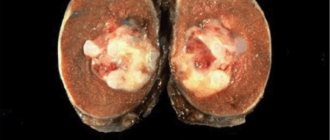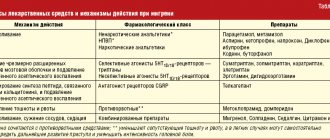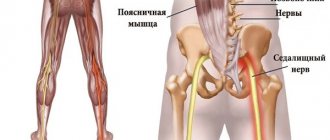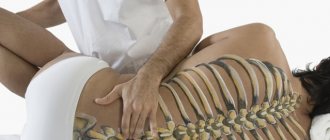Today, there are many medications for external use that help quickly get rid of pain caused by any neurological disease. Often, patients “prescribe” them to themselves, having seen enough advertising, and in the hope that such treatment will be enough. This article will consider the question of which ointment can really help with a pinched sciatic nerve, as well as what traditional methods can be used to combat this neurological disease.
What is sciatica
Sciatica (from the Greek ischias - seat) is a disease associated with pinching and inflammation of the sciatic nerve in the lumbosacral spine. Other names for this disease are lumbosacral radiculitis or sciatic neuralgia.
The sciatic nerve is the longest nerve in the body. It originates in the lower back from the nerve roots of the lumbar spinal cord and passes through the gluteal region throughout the lower limb.
An attack of sciatica is usually caused by damage to one or more roots of the lumbosacral spinal cord. But sciatica syndrome can also be caused by pinching of the sciatic nerve as a result of muscle spasm.
Massage
Sometimes it can be prescribed during an exacerbation of symptoms of a pinched nerve, but provided that they are moderate. There are relaxing and therapeutic massage complexes. During a relaxing massage session, a specialist gently massages sore areas. The muscles relax, the pain becomes less.
Therapeutic types of massage include a more intense effect on muscles and subcutaneous fat. They not only relax spasmed muscles, but also restore sensation in the leg on the affected side. The duration of one visit is 20-60 minutes.
At home, vacuum cupping massage has an excellent pain-relieving effect. With its help, muscle spasms and severe pain instantly disappear.
Vacuum cupping is a good method for treating pinching at home.
Symptoms of sciatica
The clinical symptoms of sciatica vary. This may be a sharp shooting pain from the lower back to the buttock and down the back of the limb. Often observed:
- acute pain in the buttocks, which intensifies when sitting;
- shooting pain that occurs when trying to stand up;
- numbness or weakness in the leg;
- severe pain when walking or bending over.
With sciatica, pain in the buttock and the back of the thigh, often radiating to the lower leg and foot, is more pronounced than pain in the lower back.
Other symptoms of sciatica include pain in the leg such as burning, tingling, numbness, or pins and needles.
Most often, sciatica affects only one limb, but there are cases when the patient experiences pain in both legs.
The pain with sciatica is usually not as severe as with lumbago. In the initial stages of the disease, the symptoms of sciatica may not be very pronounced. But in advanced cases, such attacks of pain are possible that the patient cannot not only walk, but even stand and sit, and sometimes the pain does not subside even in a lying position and does not allow him to fall asleep.
Warming up
Warming drugs increase blood circulation at the site of inflammation. These substances are intended for use in the subsiding phase of the inflammatory process. Once in the blood, they prevent stagnation and help reduce pain impulses.
Be sure to read: What is a kinesio tape patch: indications and contraindications, full instructions for use, reviews
The active ingredients that are included in their composition are camphor, turpentine, peppermint. At the pharmacy you can buy ointments with the following names:
- Viprosal B - from 250 rubles;
- Finalgon - from 320 rubles;
- Nicoflex - from 310 rubles;
- Capsicam - from 300 rub.
Warming ointments should always be applied with a special applicator.
There are also turpentine ointments with camphor. They have a very strong smell. It is inexpensive - from 30 rubles. They should not be applied to the skin if it has wounds or allergies. These are products that have an instant warming effect, but they must be used very carefully. Where to apply the ointment - just apply it to the sore spots and rub in until absorbed.
If the skin reacts to the use of warming ointments with a rash or burning sensation, you should not apply them to the lower back.
Causes of sciatica
The immediate cause of sciatica is irritation or pinching of the sciatic nerve or the nerve roots that form it. But the reasons for this irritation can be different.
The most common cause of sciatica is a herniated disc, which compresses the sciatic nerve roots. Also, irritation of the nerve roots can be caused by osteophytes - bone formations on the joints of the spine that occur with osteochondrosis or spondyloarthrosis.
Spondylolisthesis (displacement of one vertebra relative to another), as well as inflammation and spasm of the lumbar or gluteal muscles (usually the piriformis muscle) can lead to pinching or compression of the nerve roots that form the sciatic nerve.
Attacks of sciatica can also be caused by injuries (including birth), tumors, internal bleeding, diabetes, infectious or gynecological diseases. Therefore, if the symptoms of sciatica are acute or bother you for a long time, you need to consult a doctor and undergo an examination in order to correctly diagnose the disease.
Manual therapy
Manual therapy is often confused with massage, but they are two different procedures. Massage therapists influence the skin, muscle and subcutaneous fat layers. Chiropractors deeply “work” certain muscle groups, realigning the joints and ligaments of displaced vertebrae into place.
Manual therapy is contraindicated in severe cases - for example, when the patient has a severe hernial protrusion with persistent and severe pain. In this situation, only surgical treatment methods can help.
The main thing when treating manual therapy is to find a qualified specialist so as not to cause harm.
Massage, acupuncture and manual therapy are manipulations that require a high degree of professionalism and responsibility from a person. You need to contact only professionals: it is both effective and safe for health.
Be sure to read: TOP 35 patches for arthritis and arthrosis (Chinese, painkillers, magnetic), how to use
Clinical picture of sciatica
Most often, sciatica develops gradually. At the onset of the disease, slight pain is observed in the lumbar spine and (or) buttocks, as well as a feeling of fatigue and aching legs. But often these symptoms - pain in the lower back, buttocks, fatigue and tension in the legs - are considered overwork.
In the future, the unpleasant sensations may become longer and more intense. But often sciatica in the initial stage continues for quite a long time (up to several years), until a serious exacerbation is caused by some external cause, sometimes quite harmless - a jump, a sharp turn, a fall, heavy lifting, or banal hypothermia. It is with this reason that patients associate the onset of the disease, forgetting about the first symptoms that went unnoticed.
Chondroprotectors
Chondroprotectors contain chondroitin. This is a substance that is part of the ligaments, cartilage and discs of our spine. Ointments - chondroprotectors prevent destruction of the ligamentous apparatus and restore damaged connective tissue:
- Teraflex - from 400 rub.;
- Honda - from 150 rubles;
- Chondroxide - from 400 rubles;
- Chondroitin - from 80 rub.
Chondroxide will help restore damaged cartilage tissue.
They are prescribed not only for pinched nerves in the lower back, but also for other inflammatory diseases of the spinal column.
It is interesting that in medical circles there has been debate for a long time about the effectiveness of the use of chondroprotectors in the treatment of diseases of the spine and joints.
Treatment of sciatica
When treating sciatica, it is first important to minimize movement in the affected limb to reduce irritation of the nerve roots. Rest is recommended, the bed should be flat, the legs should be bent at the knee and hip joint and slightly elevated (you need to choose a comfortable position).
In order to relieve pain and inflammation, as well as muscle spasms, analgesics, NSAIDs, and antispasmodics are used. Warming and pain-relieving ointments and gels are prescribed. In the future, physiotherapy, acupuncture, massage and exercise therapy are recommended.
However, modern medicine can offer effective and safe treatment, which can significantly enhance the effect of traditional medications, and in some cases, completely abandon drugs that are unsafe for health. This is a therapeutic anti-inflammatory pain relieving patch NANOPLAST forte.
Treatment of sciatica with therapeutic anti-inflammatory analgesic patch NANOPLAST forte
In the treatment of sciatica, the NANOPLAST forte therapeutic patch has shown high effectiveness. The use of this drug can quickly improve the patient’s condition - reduce pain symptoms, relieve muscle spasms.
Therapeutic pain-relieving anti-inflammatory patch NANOPLAST forte can be used both in the complex treatment of sciatica and as monotherapy. The patch is applied to the lumbar spine and, if necessary, to the gluteal region, depending on the location of the pain. Up to 3 patches can be used at the same time.
In order to get rid of sciatica, you need not only to relieve the pain symptom, but also to improve metabolic processes in the intervertebral discs, remove inflammation, eliminate muscle spasms, improve blood supply and nutrition of nerve endings, stop or at least slow down the development of osteochondrosis. The use of NANOPLAST forte allows you to solve this problem.
Thanks to the simultaneous influence of two physiotherapeutic factors - deep soft warming heat of infrared radiation and the influence of a magnetic field with specially selected characteristics - this innovative drug allows you to relieve pain and inflammation, improve blood circulation in the affected area, and reduce the dose of painkillers and anti-inflammatory drugs.
To relieve acute symptoms in the treatment of sciatica, a therapeutic patch is used for 3 to 5 days. The duration of the course of treatment is from 9 days. It is usually recommended to use the treatment patch in the morning for 12 hours, but it can also be used at night.
High efficiency, unique composition, long-term (up to 12 hours!) therapeutic effects, ease of use and affordable price make NANOPLAST forte the drug of choice in the treatment of sciatica.
The medical patch NANOPLAST forte is sold only in pharmacies.
Read more about NANOPLAST forte
Nonsteroidal anti-inflammatory drugs
These gels and creams are effective for various types of inflammatory processes. They are used not only to treat sciatica. For example, they help well with inflammation of the trigeminal nerve. If you apply the medicine to the affected area, its active substance immediately penetrates the skin into the tissue, relieving swelling and pain.
It is recommended to use any of these drugs for no more than three weeks. These include:
- Diclofenac (analogues: Voltaren emulgel, Ortofen)
. Inexpensive gel, also available in ointment form. The main drug included in its composition is diclofenac sodium. Has no color, transparent or with a yellowish tint, uniform consistency. It is applied to clean skin two or three times a day and gently rubbed until completely absorbed. The maximum course of treatment is two weeks. Price - from 50 rub.
Diclofenac ointment has a good effect and a low price - Ibuprofen . Viscous, opaque white ointment. It has a specific smell and thick consistency. It should be applied in a strip of 5 to 10 cm and also rubbed in until completely absorbed. The maximum course of treatment is 21 days. Costs from 40 rubles.
- Piroxicam . Light yellow gel with a glossy tint. It is applied to clean skin by squeezing it out of the tube. After application, rub lightly and apply a compress. Price - from 150 rub.
- Nise gel . Transparent yellow gel. Squeeze a small strip onto the skin and spread it evenly. No need to rub. Apply 3 times a day. Costs from 200 rub.
After using any product, be sure to wash your hands with warm water and soap.
Be sure to read this good article:
TOP 12 methods of drug treatment for sciatica, list of the best drugs









